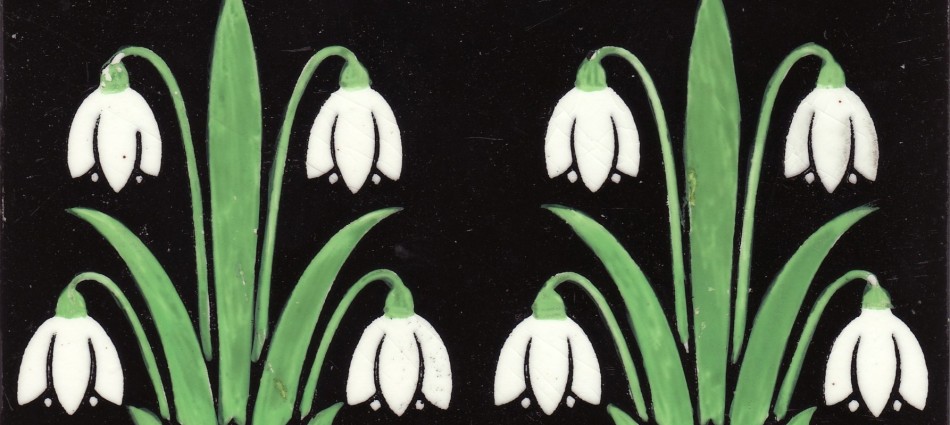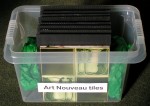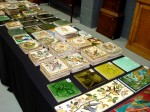Hans van Lemmen | Historical Tiles writing about tiles and architectural ceramics

TILE COLLECTING
- tiles safely and securely stored in plastic box
- Delft tiles in the window of an antique shop in Cambridge
- Tiles laid out for viewing at Fieldings Auctioneers in 2008
- The Annual Nottingham Tile Sale
Decorative tiles are now eagerly sought after, and their designs and pictures make them coveted items for many collectors. They are still freely available at antique fairs, in antique shops, from architectural salvage firms and at tile auctions, or can be bought on e-bay. Once a tile has been acquired, most collectors want answers to a number of basic questions. Who was the manufacturer? Who was the designer? When was it made? How was it made? What does the design represent? The answers can often be found by studying the tiles themselves and by consulting specialist literature or internet web-sites on the subject. In order to care for a collection effectively it is also useful to follow certain basic guide lines which will help to preserve tiles in good condition as well as help display them to their best advantage.
The tiles in your collection are worth studying closely. The front can reveal a lot about how it was decorated but the back can be even more interesting than the front providing information about the manufacturer and the date of production. For example, many late nineteenth century and early twentieth century tiles have the name or trade mark of the manufacturer stamped on the back as well as the place of manufacture. There are now several publications which provide detailed information on tile backs and their markings. Some tiles also show design registration marks, which will reveal which year the design was registered with the patent office in London.
In many cases it is not difficult to establish the name of the manufacturer, but many tile designers unfortunately remain anonymous, particularly in the case of tiles produced for the mass market. Occasionally the initials or the name of a designer can be found on a tile or a tile panel but these are the exceptions. Tiles can be attributed to certain designers on the basis of style but much of this depends on informed knowledge about the work of the designers in question and the manufacturer they worked for. However undertaking research in this area can be very rewarding and lead to new insights.
Like any other antiques, tiles need to be looked after and there are a great many things a collector can do to display, store, conserve, photograph and catalogue tiles properly. How tiles are displayed is always a matter of personal taste and dependent on available space and financial means. Tiles can be effectively displayed on shelves and ledges or hung on the wall with wire or adhesive hangers. Some collectors prefer to frame their tiles in wooden or metal frames which give a homogenous and professional finish to the display. Whatever display technique is adopted, it is more effective if it allows for tiles to be arranged in groups to show specific types of subject matter, particular manufacturers or specific decoration techniques. Before embarking on fixing tiles more permanently as part of interior fittings such as fireplaces, kitchen or bathroom walls, the collector should consider carefully what is involved. The standard rule is that the process should be reversible and that when necessary the tiles can be removed without damage. Therefore such as adhesives as Portland cement should never be used as the bonding is permanent and the tiles cannot be separated from it.
Most collectors will eventually reach the point when they have more tiles than display space. Surplus tiles can be stored with care in strong cardboard or plastic boxes. The best is to place them in an upright position with a piece of cardboard or thin polystyrene between each tile and keep them in a dry and accessible place. Multiple tiles are heavy so store them in small boxes which are easier to lift and handle. Do not store the boxes on top of each other as downward pressure could crack the tiles at the bottom of the pile. Mark the box clearly on the outside with information about its content. This will avoid having to look through all the tiles when a particular example is required.
When tiles are dirty and need to be cleaned, do not use ordinary tap water which can cause salt growths and damage the tile between the body and the glaze. Always use distilled water and a non-ionic detergent. Do not use abrasive cleaning pads which can score the glaze, but use cotton wool pads dipped in a cleaning solution. When the tile is clean, rinse it with distilled water and leave it to dry naturally. When the tile is dry it can be gently buffed with dry cotton wool. Organic stains can often be successfully removed by using Hydrogen Peroxide which is commonly available from chemists. Soak the tile first in distilled water and apply a poultice soaked in Hydrogen Peroxide to the stained area and leave to sit. Never use bleach or acid cleaners as they can the damage the clay body and the glaze. Tiles with brown films of smoke deposits can be cleaned by wiping them with methylated spirit.
Tiles that have been painted over can easily be cleaned with paint stripper and a soft plastic scraper but care should be taken not to use metal implements as they may scratch the glaze surface. Tiles that have been used in damp areas and have absorbed salt from the wall on which they were fixed can produce a white bloom of salt crystals. This can be removed by putting the tiles in a bath of de-ionised water and leaving them to soak, while changing the water several times. The tiles should then be left to dry naturally before displaying them.
Damaged tiles can be restored up to a point by simple means. Broken tiles can be mended with the various types of synthetic glue. Only tiny amounts are needed to ensure close and strong bonding. Missing glaze areas can be filled with the use of fine plaster-based filler which can then be painted to match the colour of the tile. It is always difficult to reproduce the effect of a glossy glaze but a final application of clear varnish or lacquer over the painted areas will go some way to matching the glaze of the tile. The point of restoration is not to make the tile look as new but to allow appreciation of the design and colour of the tile without the obvious distraction of missing pieces. However if you require restoration of ‘invisible mending’ standards then you must seek advice from a professional restorer specialising in ceramic ware.
Creating a catalogue of your tiles is another interesting aspect of tile collecting. The easiest way of doing this is to number each tile on the back with a small adhesive label and then to write the tile number, colour, size, manufacturer, designer, subject matter, place of acquisition and price paid on standard sheets of loose paper which can be kept in a ring folder. The entries can be made more extensive when additional information is found. A useful addition to a written catalogue is a photograph of the tile alongside each entry. It is best to photograph tiles in daylight which avoids the necessity of flash. Flash photography in-doors often results in the flash bouncing off the glazed surface of the tiles which creates blurred photographs. For those who want a more professional looking image, a single reflex camera and copy stand are recommended. In this way tiles can be photographed absolutely square and level and the pictures used in conjunction with a catalogue or just kept in an album or in a computer file for reference purposes. If you have a good scanner it is also possible to scan tiles and save the images to your computer thus avoiding photography altogether.
Responsible collectors are aware of the vanishing heritage of decorative tiles. The demand for tiles is high and they are sometimes removed unnecessarily or illegally from their original architectural locations. Such removal of tiles not only robs us of already scarce tile installations, but inexpert removal often results in much breakage and damage, so that not even the tile collector profits from this kind of activity. Many collectors are now members of societies that not only serve the interests of collectors, but these societies also encourage and support conservation and organise visits to buildings with interesting tile installations. Seeing tiles as part of buildings makes you more aware how tiles were used in architectural settings and that this is where they should be preserved.



